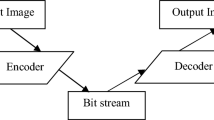Abstract
We select 93 video sequences encoded/decoded by Microsoft MPEG-4 software to classify them into six different content characteristics by the cluster analysis and the discriminant analysis in this study. We compare the peak signal noise ratio (PSNR) of objective video quality evaluation with the mean opinion score of subjective quality evaluation to understand their difference by varying different bit rate. We find that the acceptable satisfaction of user perceived quality for different motion and texture characteristics is significantly different in varying the bit rates. For the low motion and simple texture characteristic (Type 1) and the low motion and complex texture characteristic (Type 4), when the bit rate is 2,000 kbps, the tolerable discarded ratio is allowed to 44% and 49%, and the PSNR is 41.7 dB and 41.0 dB, subjects could perceive the acceptable satisfaction of video quality. For the middle motion and simple texture characteristic (Type 2) and the high motion and simple texture characteristic (Type 3), when the bit rate needs around 3,000 kbps, the tolerable discarded ratio must be controlled below 12% and 34%, and the PSNR is 45.2 dB and 41.7 dB, subjects could perceive the acceptable satisfaction of video quality. For the middle motion and complex texture characteristic (Type 5) and the high motion and complex texture characteristic (Type 6), when the bit rate is 6,000 kbps, the tolerable discarded ratio is allowed to 14%, and the PSNR is 43.2 dB and 42.9 dB, subjects could perceive the acceptable satisfaction of video quality.
Graphical Abstract









Similar content being viewed by others
Notes
Microsoft, ISO/IEC 14496 MPEG-4 Video Reference Software. Version: Microsoft-FDAM1-2.5-040207.
References
Aeluri PK, Bojan V, Richie S, Weeks A (2004) Objective quality analysis of MPEG-1, MPEG-2, and Windows Media video. In: The 6th IEEE southwest symposium on image analysis and interpretation, 28–30 March 2004, pp 221–225
Alpert Th, Evain J-P (1997) Subjective quality evaluation—the SSCQE and DSCQE methodologies, vol 271. ITU-R Recommendation BT.500–7, pp 12–20, Spring 1997
Apteker RT, Fisher JA, Kisimov JA, Neishlos H (1995) Video acceptability and frame rate. IEEE Multimed 2(3):32–40
Chandler DM, Hemami SS (2007) VSNR: a wavelet-based visual signal-to-noise ratio for natural images. IEEE Trans Image Process 16(9):2284–2298
de Cuetos P, Reisslein M, Ross KW (2003) Evaluating the streaming of FGS-encoded video with rate-distortion traces. Institut Eurecom Technical Report RR-03-078, June
Ghinea G, Thomas JP (2005) Quality of perception: user quality of service in multimedia presentations. IEEE Trans Multimed 7(4):786–789
Gulliver SR, Ghinea G (2004) Changing frame rate, changing satisfaction? IEEE Int Conf Multimed Expo 1:177–180
Hair J, Anderson R, Tatham R, Black W (1998) Multivariate data analysis, 5th edn. Prentice Hall, Upper Saddle River
Hands DS (2004) A basic multimedia quality model. IEEE Trans Multimed 6(6):806–816
Huynh-Thu Q, Ghanbari M (2008) Scope of validity of PSNR in image/video quality assessment. Electron Lett 44(13):800–801
Ito Y, Tasaka S (2005) Quantitative assessment of user-level QoS and its mapping. IEEE Trans Multimed 7(3):572–584
ITU-R Recommendation BT.500-11 (2002) Methodology for the subjective assessment of the quality of television pictures. ITU, Geneva, Switzerland
Lu ZK, Lin W, Yang XK, Ong EP, Yao SS (2005) Modeling visual attention’s modulatory after effects on visual sensitivity and quality evaluation. IEEE Trans Image Process 14:1928–1942
Nam J, Ro YM, Huh Y, Kim M (2005) Visual content adaptation according to user perception characteristics. IEEE Trans Multimed 7(3):435–445
Pinson MH, Wolf S (2004) A new standardized method for objectively measuring video quality. IEEE Trans Broadcast 50(3):312–322
Rohaly AM et al (2000) Video quality experts group: current results and future directions. In: Proceedings of SPIE visual communications and image processing, vol 4. Perth, Australia, June 2000, pp 742–753
Sheikh HR, Bovik AC (2006) Image information and visual quality. IEEE Trans Image Process 15(2):430–444
T1.801.03 (2003) American National Standard for Telecommunications—digital transport of one-way video signals—parameters for objective performance assessment. American National Standards Institute
van der Schaar M, Radha H (2001) Temporal-SNR rate-control for fine-granular scalability. Int Conf Image Process 2:1037–1040
Wang Z, Bovik AC (2009) Mean squared error: love it or leave it? IEEE Signal Process Mag 26(1):98–117
Wang Z, Li Q (2007) Video quality assessment using a statistical model of human visual speed perception. J Opt SocAm A 24(12):61–69
Wang Z, Lu L, Bovik AC (2004) Video quality assessment based on structural distortion measurement. Signal Process: Image Commun 19(2):1–9
Winkler S, Mohandas P (2008) The evolution of video quality measurement: from PSNR to hybrid metrics. IEEE Trans Broadcast 54(3):660–668
Yadavalli G, Masry M, Hemami SS (2003) Frame rate preferences in low bit rate video. Int Conf Image Process 1:441–444
Yao S, Lin W, Lu Z, Ong Z, Etoh M (2003) Objective quality assessment for compressed video. ISCAS ’03. In: Proceedings of the 2003 international symposium on circuits and systems, vol 2. 25–28 May, pp 688–691
Zink M, Schmitt J, Steinmetz R (2005) Layer-encoded video in scalable adaptive streaming. IEEE Trans Multimed 7(1):75–84
Acknowledgment
This work was supported by the National Science Council of the R.O.C under Contract NSC 97-2221-E-309-010.
Author information
Authors and Affiliations
Corresponding author
Rights and permissions
About this article
Cite this article
Sun, HM., Huang, YK. The difference between perceived video quality and objective video quality. J Vis 13, 159–168 (2010). https://doi.org/10.1007/s12650-009-0013-6
Received:
Accepted:
Published:
Issue Date:
DOI: https://doi.org/10.1007/s12650-009-0013-6




